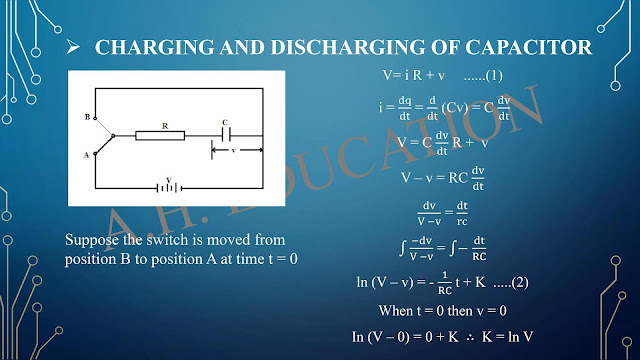ELECTROSTATICS & CAPACITORS
ELECTRIC CHARGE
• Amount of current flowing in a conductor is measured in electric charge.
• Two different kinds of charge, positive and negative.
• It’s denoted by Q or q.
• Electric charge is measured in Columb (c).
LAWS OF ELECTROSTATICS
• The space around a charge is always under stress, and experiences a force on
another charge when placed there.
• The region or space in which stress exists is called the electric or dielectric
or electrostatic field.
• The stress in the space is represented by the line of force.
PERMITTIVITY
• Permittivity of free space.
• The permittivity of free space is a physical constant used often in electromagnetism.
• It represents the capability of a vacuum to permit electric fields.
• It is also connected to the energy stored within an electric field and capacitance.
ELECTRIC FIELD
• It is found that in the medium around a charge a force acts on a positive and
negative charge when placed in that medium.
• If the charge is sufficiently large, then it may create such a huge stress as to
cause the electrical rupture of the medium, following by the passage of an arc
discharge.
• The region in which the stress exists or in which electric forces act is called as
electric field or electrostatic field.
COULOMB’S LAW OF ELECTROSTATIC
• Coulomb's first law:
• When two charged bodies are placed near each other, mechanical force is
experienced on them.
• According to coulomb’s first law charges of same nature repel one another
and that of opposite nature attract.
• Coulomb’s second law:
• According to coulomb’s second law the force between the two charge
i) is directly proportional to the product of the charge
ii) inversely proportional to the square of distance between them
iii) depends on the nature of the medium surrounding the charge.
F𝛼𝑄1𝑄2/𝑑^2F=K 𝑄1𝑄2/𝑑^2
K = 1/4𝜋𝜖 [𝜖=𝜀0𝜀𝑟]
K= 1/4𝜋𝜀0𝜀𝑟
F = 𝑄1𝑄2/4𝜋𝜀0𝜀𝑟𝑑^2
ELECTROSTATIC INDUCTION
• It is found that when an uncharged body is brought near a charge body, it
acquires some charge.
• This phenomenon of an uncharged body getting charged merely by the nearness
of a charged body is known as induction.
ELECTRIC FLUX
• Electric flux is the rate of flow of the electric field through a given area.
• Electric flux is proportional to the number of electric field lines going through
a virtual surface.
FLUX DENSITY
• Electric flux density is electric flux passing through a unit area perpendicular
to the direction of the flux.
• Electric flux density is a measure of the strength of an electric field generated by a free electric charge, corresponding to the numberof electric lines of force passing through a given area.
ELECTRIC FIELD INTENSITY
• The electric field intensity of a point due to a number of a charge is equal to the vector sum of an electric field intensity of individual charge.
• The number of electric lines of force passing through an area held perpendicularly is called electric flux.
ELECTRIC POTENTIAL
• An electric potential is the amount of work needed to move a unit of charge
from a reference point to a specific point inside the field without producing an acceleration.
• The electric potential at infinity is assumed to be zero.
• Its SI unit is joule per coulomb Volts.
CAPACITOR
• Capacitance is the property of a capacitor to store electric charge and is defined as the charge required raise its potential through unity.
• When a charge of Q coulombs is given to a conductor and if its potential rises from 0 to V volts then the capacitance of the conductor will be given by
C= 𝑄/𝑉
• In SI system the capacitance is measurement in farads.
• 1𝜇𝐹 = 10^(−6)
• 1𝜇𝜇F = 1 pF = 10^(−12 F)
• 1 nF = 10^(−9)F
CLASSIFICATION OF CAPACITOR OR TYPE OF CAPACITOR
(A) Based on Configecation :
▪ Sphirical capacitor
▪ Cylindrical capacitor
▪ Parallel plate capacitor
(B) Dry electric :
▪ Pepar capacitor
▪ Mica capacitor
▪ Siramic capacitor
(C) Polarizedcapacitor:
▪ Non polarized capacitor
▪ Polarized
(D) Variability :
▪ Fixed capacitor
▪ Hard verilable capacitor
▪ Trimar type
CAPACITOR IN SERIES
• When the negative plate of one capacitor is connected to the postive plante of another capacitor.
V= 𝑉1+𝑉2+𝑉3
𝑄/𝐶=(𝑄/𝐶1)+ (𝑄/𝐶2)+ (𝑄/𝐶3)
1/𝐶=(1/𝐶1)+(1/𝐶2)+(1/𝐶3)
CAPACITOR IN PARALLEL
• When one place of each is connected to the positive terminal of the supply mains and the other plate of each capacitor to the supply mains.
Q = 𝑄1 + 𝑄2 + 𝑄3
CV = 𝐶1V + 𝐶2V + 𝐶3V
C = 𝐶1 + 𝐶2 + 𝐶3
ENERGY STORED IN CAPACITOR
Capacitor is connected with supply voltage V. then capacitor is charged by supply.
V= Q/C Now the dq charge has to be carried to the plate of the capacitor










Comments
Post a Comment